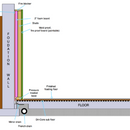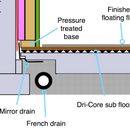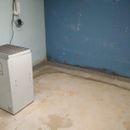Advice for foundation wall insulation in a basement in New England
Hello, I’m new to this site. We are in the process of refinishing our basement and just had a company come to install a french drain and remove mold following some growth on foundation walls and a few sections of plasterboard that were located on partition walls. Our 1969 home is in MA and the water table is often high as we live 100ft from wetland. The basement is a cold cave in the winter unless we stick up the heat (which does a great job), but it gets expensive to heat a cave. In the summer, we have high humidity outside and also in the basement. Great for mold.
After getting a quote for an OC finishing system, I plan on trying to do as much as I can myself. I am quite handy and can learn a few tricks quickly.
The end game:
1. Finished walls, insulated to keep out the cold. Insulated rim joists (I may get someone to come in to do the latter).
2. Finished floor – some kind of subfloor like dricore or DMX, with a synthetic floor on top that is moisture and mold resistent. A neighbour had used Coretec in their remodel.
3. Finished ceiling – drop ceiling with removable and mold resistant tile.
4. Final space to be used as our main entrance to driveway, sofa or two for kids when they grow older, exercise equipment and our storage of luggage etc.
What we had done recently:
We had a company come in to remove moldy plaster (a small section of our large basement had some partition walls; the rest was painted concrete wall) and moldy paint from sections of the foundation wall that had been incorrectly been applied with latex paint. They dug a trench, installed a french drain and then a mirror drain. They also installed a dehumidifer that drains into the mirror drain. It runs a lot, but is set to normal. I can only presume it is just humid.. Attaching a photo of corner where worst mold was after they installed the drain and before they removed the section of moldy paint. The wall is indeed damp behind there.
Some Problems – I have various obstructions to work around such as:
electrical panel,
3x wall mounted radiators. I would need to get a plumber to remove, then reinstall when new finished wall is up.
2 oil tanks close to the wall. These can’t be moved. I was thinking I could just leave that section unfinished and install a partition wall around them, with a louvered door. I could place the dehumidifier in there and it could then pull in the air from that room plus the outside via the door. There would be some heat loss if I don’t insulate in here.
Some tight space in a laundry room that would be tricky. I could maybe pass and do the same as the oil tank.
a staircase butting up to the edge of the foundation that absolutely cannot be moved (no room for insulation / studs there, just room for a sheet of plaster / some vapor barrier)
Attaching a layout of the basement that I am working on:
legend: turquoise = partition wall / sheetrock or similar; pink = insulated section.
footprint = 57×26 ft at widest points.
Idea for insulation:
Install vapor barrier on wall, tuck into mirror drain so that all moisture from wall goes into french drain.
Install sub floor up to the edge of the mirror drain
Install a pressure treated baseplate (to build studs on / rest XPS on.
Install foam board to wall against the vapor barrier: Owens Corning XPS or Dow Super Tuff-R If I have a vapor barrier, guessing the XPS is ok.
Install steel studs over the foam board. I may get a rough carpenter to do that
Install a mould resistant board over the studs. I have to review building codes; people ‘say’ gypsum for fire barrier, but perhaps the MA building code would allow a fire and mold resistant board, like Magnesium Oxide.
Does anyone have any thoughts? I’m really looking for advise at this stage on:
1. the right way to insulate for this type of environment that doesn’t encourage mold growth. Does my approach make sense, or am I aiming for disaster? For example:
a) is vapor barrier OK to use?
b) Should I be concerned about the dricore floor venting into the space below the foam board, encouraging it to get damp? For example I have read XPS when damp doesn’t perform well, ants like to eat it.
c) is XPS ok, or is Dow Super-Tuff-R better for this application – is Super Tuff-R more moisture resistant? I have read that I could go just with super-tuff-r without a vapor barrier, but don’t think I can channel the board into the drain by itself unless I cut out some kind of wedge at the bottom. Ideally I would like to skip the vapor barrier entirely if I can find a good performing insulation board that meets my needs.
2. Whether leaving out sections of the basement that aren’t very accessible (e.g. the electrical panel, oil tanks) is a good idea or not. I will of course have to ensure any flammable foam is encapsulated with fire blocking material.
GBA Detail Library
A collection of one thousand construction details organized by climate and house part













Replies
Rob Brown,
I suggest that you start by reading this article: Fixing a Wet Basement.
If you still have questions after reading this article, feel free to post them here.
You don't need both a vapor barrier AND foam board on the foundation wall. Foam board is already sufficiently vapor retardent.
At 2" the foam does not meet current IRC 2015 code-minimum for foundation insulation in any New England climate zone. It needs to be R15 continuous insulation, or the thermal equivalent thereof. With steel studs 24" o.c. you could add unfaced batts designed for steel studs (they're wider than for 2x4 studs) and just make it with 2" of EPS.
XPS will degrade to the same performance level as EPS over the lifecycle of a house as it loses it's climate-damaging HFC blowing agents so don't assume more than R4.2/inch for the long haul. EPS and polyiso are blown with MUCH more benign pentane, and would be greener options here.
If using polyiso the cut edge at the bottom needs to be above the high-tide mark of any flooding, since it can wick up moisture. Polyiso will meet code min-R at just 3", and as long as the upper half of the wall is polyiso (R16-R18), continuing with 3" of EPS (R12-R13.6) below wouldn't be an energy disaster, even if a bit sub-code.
Tape all the foam seams with an appropriate air-sealing tape, and can-foam or polyurethane caulk the top & bottom of the foam to the foundation to prevent convection through that thin air space.
Using 1x furring through-screwed through the 3" foam to the foundation with 4.5-5" masonry screws to the foundation, mounting the wallboard to the furring works well, but requires some cut outs & trenching into the foam for any electric wiring & electrical boxes. That takes up less space in the room than a 2" foam + studwall solution.
If using steel studs, use steel top & bottom plates, not the pressure treated 2x lumber called out in the drawings.
In New England there are multiple vendors of reclaimed roofing foam, typically at 1/4-1/3 the cost of virgin stock foam. The two largest are Nationwide Foam in Framingham, MA, and Green Insulation Group in Worcester, MA, but there are several others. Searching your local craigslist for the terms rigid + insulation usually gets several hits. eg:
https://maine.craigslist.org/search/sss?query=rigid+insulation
https://vermont.craigslist.org/search/sss?query=rigid+insulation
https://hartford.craigslist.org/search/sss?query=rigid+insulation
Re-using foam is the greenest of all solutions, since it uses no new polymer or blowing agent. Any type of foam is fine, but be sure to derate accordingly since performance for some types decline below their labeled-R over time. XPS should be assumed to be no better than R4.2/inch, polyiso no more than R5.5/inch. Most reclaimed EPS is Type-II (1.5ls nominal density), which is a fairly stable R4.2/inch over decades.
Martin, Dana, thanks for links and the detail. I will review closely. Our building inspector came by to sign off on the french drain system and he mentioned that the new ISO standards are up to R21 now. So that's approx 3 inches thick... which I can't find anywhere.
If I buy new, it seems that polyiso may be the best option. Since we have a french drain system I am not concerned about flooding, but would likely be finishing the foam 2-3 inches above the floor in order to tuck it into the mirror drain.
I will likely go with steel studs; it may be easier for me to install and may even be lower cost.
I may see if I can buy all the materials for floor, walls, to try out one section of the basement wall first before buying large quantities. Thanks for the advice.
What means "...new ISO standards are up to R21 now..." ???